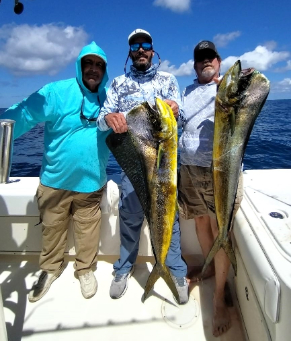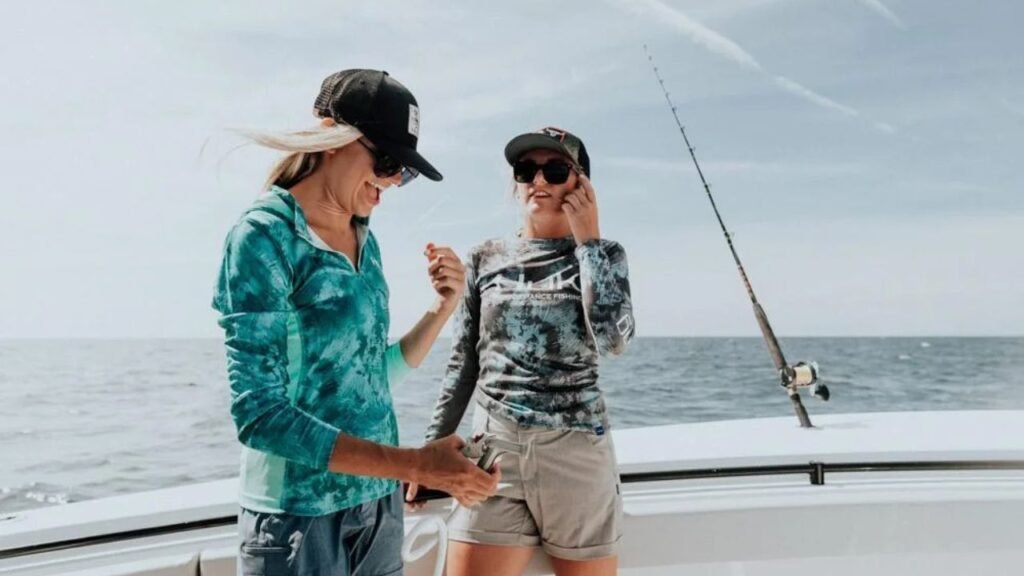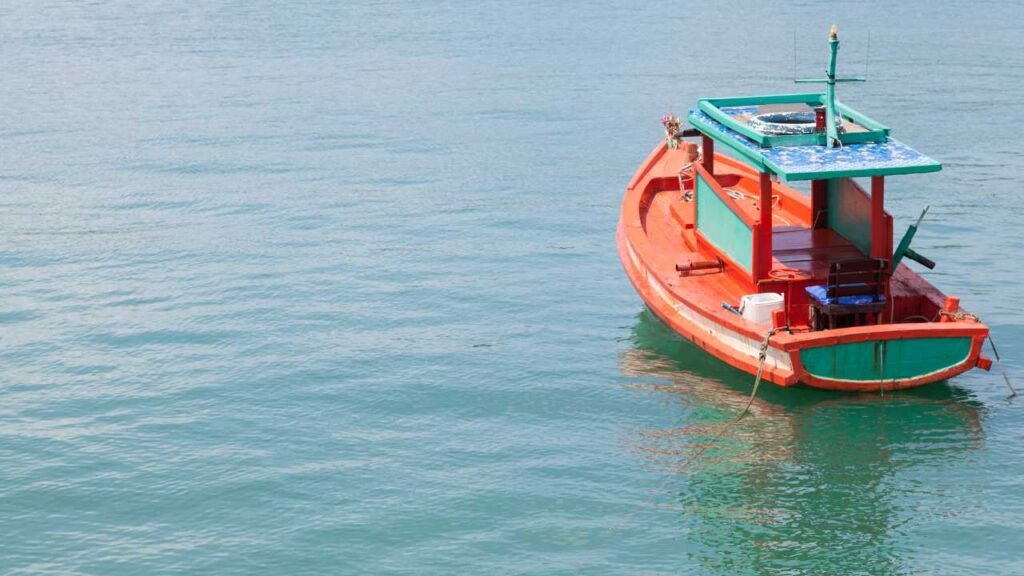Wear lightweight, moisture-wicking clothing and non-slip, waterproof shoes. Bring a hat, sunglasses, and sunscreen for sun protection.
Fishing on a boat requires specific attire for comfort and safety. Lightweight, moisture-wicking clothing helps keep you cool and dry. Non-slip, waterproof shoes ensure stability on wet surfaces. A wide-brimmed hat and polarized sunglasses protect you from the sun’s glare and harmful UV rays.
Sunscreen is essential to prevent sunburn during long hours on the water. Dressing appropriately enhances your fishing experience by keeping you comfortable and safe. Always check the weather forecast before heading out to ensure you are adequately prepared. The right gear and clothing can make your fishing trip more enjoyable and successful.
Choosing The Right Clothing
Fishing on a boat can be fun and rewarding. But, wearing the right clothes is key. The right clothing keeps you comfortable and safe. Let’s explore what to wear fishing on a boat.
Weather Considerations
Check the weather before you go fishing. Sunny weather calls for light, breathable clothing. Wear a hat and sunglasses to protect from the sun. Use sunscreen on exposed skin.
For cold weather, layer your clothes. Start with a moisture-wicking base layer. Add an insulating middle layer. Finally, wear a waterproof outer layer. This keeps you warm and dry.
Rainy weather requires waterproof gear. A waterproof jacket and pants are essential. Wear non-slip shoes to stay safe on wet surfaces.
Material Choices
Choose the right materials for your fishing trip. Cotton absorbs water and dries slowly. Avoid cotton if you expect to get wet.
Synthetic fabrics like polyester and nylon are great. They dry quickly and wick away moisture. These fabrics are ideal for fishing.
Wool is a good choice for cold weather. It keeps you warm even when wet. Wool socks can keep your feet warm and dry.
| Weather | Clothing |
|---|---|
| Sunny | Light, breathable clothing, hat, sunglasses, sunscreen |
| Cold | Moisture-wicking base layer, insulating middle layer, waterproof outer layer |
| Rainy | Waterproof jacket and pants, non-slip shoes |
Remember, the right clothing makes your fishing trip enjoyable. Choose wisely based on the weather and materials. Happy fishing!

Credit: fishpanamatoday.com
Footwear For Stability
Choosing the right footwear for fishing on a boat is crucial. You need shoes that provide stability and comfort. This ensures safety while moving around the boat. It’s important to choose the right type of shoes to avoid slipping and injuries.
Non-slip Shoes
Wearing non-slip shoes is essential for fishing on a boat. These shoes have special soles that grip the wet deck. This reduces the risk of slipping. Here are some features to look for in non-slip shoes:
- Rubber outsoles with deep treads
- Water-resistant materials
- Comfortable insole padding
Non-slip shoes come in various styles. Choose the one that fits well and feels comfortable. Proper fit is important for long hours on the boat.
Waterproof Options
Another key feature is waterproof shoes. These shoes keep your feet dry and warm. Wet feet can lead to discomfort and health issues. Here are some waterproof options to consider:
| Type | Features |
|---|---|
| Rubber Boots | Fully waterproof, easy to clean |
| Waterproof Sneakers | Comfortable, stylish, and breathable |
| Neoprene Shoes | Lightweight, flexible, and water-resistant |
Choose waterproof shoes based on your needs and preferences. Remember, keeping your feet dry enhances your overall fishing experience.
Protection From The Sun
Fishing on a boat can be a lot of fun. But the sun can be very strong. You need to protect yourself from sunburn. Wearing the right clothes can help keep your skin safe.
Hats And Caps
A good hat or cap can protect your face. It can also keep your head cool. Choose a hat with a wide brim. This will cover your neck and ears too. A cap with a neck flap is also a good choice. Look for hats made from breathable fabric. They will keep you cool and dry.
Sunglasses
Sunglasses protect your eyes from the sun’s rays. They also help you see better on the water. Choose sunglasses with UV protection. Polarized lenses reduce glare from the water. This helps you see fish more clearly. Wrap-around styles offer the best protection. They block light from the sides.
| Item | Benefits |
|---|---|
| Hat or Cap | Shields face, neck, and ears from sun |
| Sunglasses | Protects eyes, improves vision on water |
- Wide-brimmed hats offer the most coverage.
- Neck flaps add extra protection.
- UV-protected sunglasses keep your eyes safe.
- Polarized lenses reduce glare from the water.
- Wear a hat or cap.
- Put on your sunglasses.
- Stay protected from the sun.

Credit: fishingbooker.com
Layering For Comfort
Fishing on a boat requires smart clothing choices to stay comfortable. The key to staying comfortable is layering. This approach helps you adapt to changing weather conditions. Let’s explore the best ways to layer your clothes for a fishing trip.
Base Layers
Base layers are the foundation of your fishing outfit. They sit closest to your skin and manage moisture. Choose materials that wick away sweat and dry quickly. Avoid cotton, as it retains moisture and can make you cold.
| Material | Benefits |
|---|---|
| Merino Wool | Soft, moisture-wicking, and quick-drying |
| Synthetic Fabrics | Lightweight, breathable, and fast-drying |
For the upper body, a long-sleeve shirt works best. For the lower body, choose leggings or long underwear. Ensure your base layers fit snugly but aren’t too tight.
Outer Layers
Outer layers protect you from wind and rain. They should be breathable and waterproof. These layers should be easy to take off and put on.
- Jacket: Choose a waterproof, breathable jacket with a hood.
- Pants: Waterproof pants keep you dry from splashes and rain.
- Footwear: Waterproof boots or shoes with good grip.
Outer layers can include additional items for extreme conditions. For instance, a fleece jacket for extra warmth or a windbreaker for windy days. Dressing in layers ensures you can add or remove clothing as needed.
Accessories For Safety
When fishing on a boat, safety is crucial. Accessories can enhance safety and comfort. Here are some must-have safety accessories for your next fishing trip.
Life Jackets
Wearing a life jacket is non-negotiable on a boat. It can save your life. Choose a life jacket that fits well and is comfortable. There are different types of life jackets for different water activities.
Ensure it is U.S. Coast Guard-approved. This guarantees it meets safety standards. Life jackets come in various sizes. Make sure everyone on board has one that fits properly.
Check the life jacket for any signs of wear or damage. Replace it if needed. A life jacket can only protect you if it is in good condition.
Gloves
Fishing gloves protect your hands from cuts and blisters. They also provide a better grip. This is especially helpful when handling slippery fish.
Choose gloves that are water-resistant and durable. Some gloves also offer UV protection. This helps prevent sunburn on long fishing trips.
Make sure the gloves fit well. They should not be too tight or too loose. A good fit ensures better control and protection.
| Feature | Benefit |
|---|---|
| Water-resistant | Keeps hands dry |
| Durable | Lasts longer |
| UV Protection | Prevents sunburn |
| Good Fit | Better control |
By wearing gloves, you can fish comfortably and safely. Protect your hands and enjoy your trip.
Rain Gear Essentials
Fishing on a boat can be an exhilarating experience. But, the weather can change suddenly. Rain gear is essential to stay dry and comfortable. Let’s explore the key items you need.
Jackets And Pants
Waterproof jackets are a must-have. Look for jackets with sealed seams and breathable fabric. They keep the rain out while allowing sweat to escape. Adjustable hoods and cuffs are important features. They help keep water from seeping in.
Waterproof pants are equally important. They should be lightweight and flexible. This ensures you can move freely. Look for pants with elastic waistbands and adjustable ankles. This helps keep water from entering.
| Feature | Jackets | Pants |
|---|---|---|
| Waterproof Material | ✔️ | ✔️ |
| Breathable Fabric | ✔️ | ✔️ |
| Adjustable Fittings | ✔️ | ✔️ |
Ponchos
Ponchos are another great option for rain protection. They are easy to put on and take off. Ponchos cover both you and your gear. This is helpful for sudden downpours.
Ponchos are lightweight and packable. You can easily carry them in your backpack. Look for ponchos with hoods and drawstrings. These features help to keep the rain out.
- Waterproof
- Lightweight
- Packable
- Hooded with Drawstrings
Choosing The Right Colors
Choosing the right colors for your fishing attire is crucial. The right colors can help you blend in with the environment or stand out for safety. Let’s dive into the best options for both scenarios.
Camouflage Options
Camouflage clothing helps you blend into your surroundings. Fish have sharp vision and can get scared easily. Wearing camo can help you avoid spooking them. Choose camo patterns that match the water and vegetation where you fish.
| Environment | Recommended Camouflage Patterns |
|---|---|
| Freshwater Lakes and Rivers | Green and Brown Camo |
| Coastal Areas | Blue and Grey Camo |
| Swamps and Marshes | Reed and Grass Camo |
Bright Colors
Bright colors can be useful for safety and visibility. If you are fishing in a busy area, bright clothing makes you easy to spot. This can prevent accidents and make rescue easier in emergencies.
- Safety Orange: Great for high visibility.
- Neon Yellow: Stands out in foggy conditions.
- Bright Red: Easy to see from a distance.
Bright colors also help your fishing partners see you. This can be important in low-light conditions or rough waters.
Storing Your Gear
Storing your gear properly is crucial when fishing on a boat. Proper storage keeps your equipment safe and organized. This ensures you can focus on catching fish. Let’s explore the best ways to store your gear.
Waterproof Bags
Waterproof bags are essential for protecting your items from water. They come in various sizes to fit different needs. You can store clothes, electronics, and other essentials. Look for bags with secure, watertight seals. This will keep everything dry.
- Durable Material: Choose bags made from tough materials.
- Easy to Carry: Opt for bags with comfortable straps.
- Multiple Compartments: These help in organizing your items.
Dry Boxes
Dry boxes offer rigid protection for delicate gear. They are perfect for storing electronics and sensitive tools. Dry boxes often have foam padding inside. This provides extra protection.
| Feature | Benefit |
|---|---|
| Waterproof Seal | Keeps contents completely dry. |
| Sturdy Build | Protects against impacts. |
| Lockable | Provides added security. |
Using both waterproof bags and dry boxes ensures your gear stays safe. This allows you to enjoy your fishing trip without worries.
Choosing the right fishing attire ensures a comfortable and successful trip. Remember to prioritize sun protection, comfort, and mobility. Layering clothes can adapt to changing weather conditions. Don’t forget essentials like hats, sunglasses, and non-slip shoes. By dressing appropriately, you’ll enhance your overall fishing experience on the boat.
Happy fishing!
FAQs:
What Are The Best Clothes For Boat Fishing?
Wear moisture-wicking, quick-dry clothes. Opt for light layers to adjust to changing weather. Long sleeves and pants provide sun protection.
Should I Wear Sunscreen While Fishing?
Yes, always wear sunscreen. Even on cloudy days, UV rays can harm your skin. Reapply every two hours.
What Type Of Shoes Are Best For Boat Fishing?
Wear non-slip, waterproof shoes. They provide grip and prevent slipping on wet surfaces. Avoid open-toed sandals for safety.
Do I Need A Hat For Fishing On A Boat?
Yes, a wide-brimmed hat is essential. It protects your face, neck, and ears from the sun.



